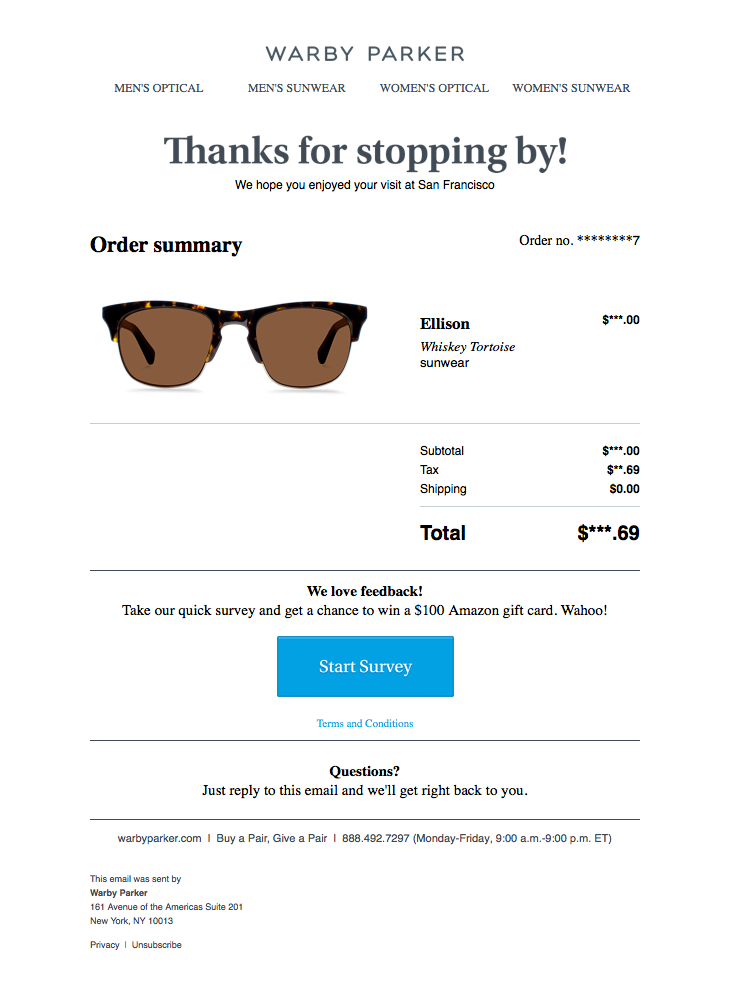For UX 201 we’re focusing on how to create a post-purchase experience that keeps customers coming back for more.
While the majority of marketing budgets are spent on customer acquisition, customer retention is a worthwhile priority. That’s because an increase in customer retention of 5% can increase profit as much as 95%.
So how do you craft a post-purchase experience that keeps your customers happy and coming back? Here are some methods to consider.
For starters, don’t let a purchase be the end of the conversation with customers. Simple thank you emails are a great starting place for continuing the conversation. But don’t rely on the default transactional emails that came with your marketing automation software tool, because they tend to look bland.
Yes, confirmation emails should be functional but they are also a great opportunity to showcase your brand and drum up excitement around the customer’s order. For instance, contrast the above email with the thank you email that Warby Parker sends.

Source: Warby Parker
Warby Parker’s email conveys all the same information as the boring one above, but does so in a way that highlights their brand and incites some excitement in the customer surrounding their order.
Good post purchase communications generally do a few things: they confirm that the customer’s order has been received, provide customers with a line to social pages and support, and encourage repeat purchases.
One way that transactional emails can encourage repeat purchases is by getting customers back to the site either with promotions or relevant, valuable content. While the first email that Warby Parker sends does include 7 or 8 links back their website, their next email, a shipping confirmation does an even better job.
Order confirmation emails tend to get opened by recipients. A Study by Experian found that transactional email open rates tend to be double typical bulk emails. Retailers should capitalize on this honeymoon phase by making it easy for new customers to come back to the site and follow on social media.
While Warby keeps their social links fairly muted in this email (in black writing at the bottom), they include three large images at the bottom of the email which entice readers into browsing their product collection, reading about their value-add options, or learning about their corporate social responsibility.
While most post-purchase emails come within a few days of a customer making a purchase, replenishment and reengagement emails are a great way to connect with shoppers that haven’t made a purchase in a while.
How long after a purchase you should wait before sending a reengagement email will largely depend on what type of products you sell. Clothing and cosmetic companies can look to reengage customers around every 8-12 weeks, whereas other industrial verticals could have a 12-16 month cycle before the ideal time for reengagement.
Warby Parker sends out an email at the one month mark and with just a few high-quality images and a few sentences of engaging copy they have created a compelling and attractive reengagement email.
Replenishment emails are a little more straight forward. If you sell a consumable product and have an idea of how long it takes before a refill is needed, then a well-timed email can make it easy for customers to buy again and save you the risk of them switching to a competitor.
MJ missed free throws, Einstein forgot to carry the 1, and retailers ship the wrong products. Everyone makes mistakes. But retailers that make it easy for customers to get in touch with support and work quickly to offer effective solutions can actually use these bad experiences to create lifelong customers. Turning bad experiences into good ones requires a few things: a prompt response, a courteous and personable tone, and effective solutions.
Consider this for example. After receiving a recent purchase from an online retailer, I realized that I preferred a different style. I reached out to their support team and received a reply within a day. They were happy to help me exchange the products and said something to the effect of “We’ve put your replacement in the mail and emailed you a return shipping label – just put the return label on the box your purchase arrived in a pop it in the mail at your convenience.”
While you don’t have to go to this length in order to keep customers happy, this example illustrates everything that goes into an effective response to a customer issue. They responded quickly, handled it in a friendly tone, and went above and beyond in terms of providing a solution.
It’s a lot cheaper to keep existing customers than win new ones. Retailers that can craft an effective post-purchase experience will keep their customers coming back for more.